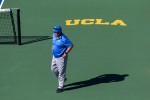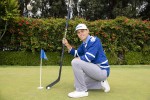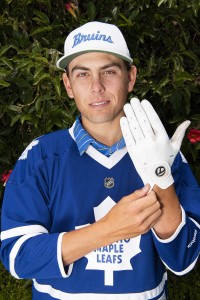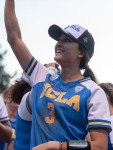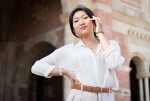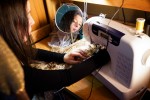Heels click on concrete, synced with music, as Meghan He pops a hand on her hip and smizes out across the stairs of Drake Stadium.
He, a first-year psychobiology student began the school year catwalking down her dorm hallway. After spending months in rehearsal spaces like Drake Stadium, He will end it strutting down a Pauley Pavilion runway in UCLA’s annual Fashion and Student Trends show.
FAST will showcase 16 student designers’ work in a runway show Thursday with about 70 student models. Some – like Skylar Kang, a third-year communication student – have modeled previously, but others like He joined FAST with no experience. Over the course of the year, the FAST models went through extensive preparation and personal growth as they got ready for the runway.
Walk Before You Runway
Models express themselves through their craft. But when one’s art medium is their own body, they must master everything from the tips of their toes to the larger facets of holistic health. It takes months to physically prepare for a runway show, shaping the body and its movements into the ideal state, Kang said.
“FAST has done what (it) can to eliminate the stress of preparing for the show by giving lots of opportunity for practice; it’s not like we started a week before the show – it’s been a monthslong process of getting ready,” Kang said. “I’m looking forward to finally feeling the energy of walking on stage for an audience.”
After two audition rounds at the start of fall quarter, the models spent their initial FAST practices learning how to properly walk a runway, with the directors breaking the process down into its smallest components. They began by focusing on how to position the legs and feet before moving onto the arms, He said. From there, they concentrated on walking, posing and turning on the catwalk.
The most important rule of runway walking, He said, is to always lead with the knee, putting the heel down first and extending the ankle before putting down the toes. This lengthens the leg in a continuous straight line, which helps high heels create the seamless illusion of long legs, she said. If the ankle isn’t extended it almost resembles a 90-degree angle between the shin and foot, disrupting the illusion.
Kang said modeling is different from looking good in person; posing for the camera or the runway requires deliberately positioning oneself in a way that may not feel natural. To train herself, Kang said she watches runway videos and takes inspiration from her fellow student models to improve her skills.
“It might feel weird walking down the runway with my chin up and head all the way extended pretending I’m on a string,” Kang said. “I’m not walking like this to class, but when you’re on stage, that’s what looks good.”
Kang said she initially struggled with striking bold poses. She always opted for safer stances she thought looked enticing but actually came across as shy on camera. Azure Gao, a second-year sociology student who also modeled for FAST in 2018, said Kang has become more creative over time, experimenting with more complex, daring poses like turning to the side and flipping her hair instead of relying on the predictable hand-on-hip posture.
He said her outfit influences her gait and facial expressions, so she curates her poses and demeanor to mesh with what she’s wearing. The outfit she will model – designed by FAST designer Hope Pham, a second-year political science and psychology student – is a feminine, satin-textured set with a voluminous, jellyfish-esque skirt. She plans on embodying the mellow vibe with softer facial expressions and by posing with her hands on her waist to give the skirt the space it needs to expand sideways, she said.
For her glittery gold open-front look – designed by Sabrina Costa, a first-year biology student – He will pose with her arms down and hands back to showcase her legs and put on a more aggressive expression to match the fierceness of the piece.
Although their outfits are the most important part of their walk, models also have to get their bodies to their healthiest point, Kang said. She said she practices a “most of the time vegan” diet that limits dairy, oils and red meats in favor of fruits and vegetables. Kang said she also tries to go to the gym regularly – even if it’s only for 10 minutes – in order to regularize workouts.
In her past modeling experiences, Kang said she realized she would panic and start exercising only as a show loomed closer. This strategy was ineffective because three days of working out was not enough to enact the physical changes she wanted to see, she said.
Three months were plenty for He to see a physical change – though it wasn’t one she expected. She said she gained the full freshman 15 during fall quarter. Coupled with a recurring ankle sprain that prevented her from running, she struggled to lose the weight through winter and spring quarters. He switched to spinning and went back to yoga, an activity she pursued in high school, by joining a program to teach yoga to elementary schoolers.
He said she woke up around 7 a.m. every day this year to fit a workout in before class, focusing more on strengthening her core than on cardio in order to improve her posture. With eight years of ballet experience, He said she has a strong mind-body connection and is used to being hyperaware of her hand, arm and leg placement. However, she had to adjust to small changes in each style of performance art, such as walking heel-toe in modeling as opposed to toe-heel in ballet. While walking seems pretty intuitive, she said the process of preparing for the FAST show further increased her awareness of her movements and taught her just how many minute physical components go into developing a skillful runway walk.
“Watching everyone at practice now, I just realize how much more prepared we look than months ago. In the beginning, I didn’t know much about the smaller details of posing or turning the corners or how to maintain that eye contact while you turn,” He said. “It’s pretty amazing – everyone looks really clean now.”
Body Positivity, But Make it Fashion
Fashion trends go in and out of style, and so do physical features, Kang said. As the one profession based almost solely on looks, modeling involves navigating a notoriously toxic industry, she said.
“The best thing I can compare an open call to is a job interview – you want to practice and prepare. But it’s so different with modeling because my preparation is not just practicing my walk and pose, but also practicing healthy eating, practicing exercise,” Kang said. “Sometimes that does get a little intense and almost feeds into this toxic energy of seeing myself negatively.”
Kang said the pressures of fitting into certain sizes or meeting specific body dimensions at open calls made her more conscious of her dietary habits, but at times also reinforced a tendency toward undereating and unhealthy mindsets. At 5 feet, 11 inches, she’s been told only once that she’s too tall for a modeling job. Yet she often finds herself comparing measurements to other models, especially Asian ones like herself.
Rohin Sharma, a first-year pre-psychology and pre-communication student and FAST model, said he also struggled with comparison and body image issues as he began the daunting process of preparing for a runway show, but he looked up to Kang for guidance. Watching how comfortable Kang is in her own skin inspired Sharma and helped strengthen his confidence. Sharma said he learned that, while a model’s individual flair is important, at the end of the day modeling is about being a canvas for the designer’s art.
“Modeling is not just about you, it’s about the product that you’re wearing, and being symbolic of the team behind you – mostly the designer, but also the team that helped make that dress, the makeup team – you’re the idol of all of the creativity that went into making it,” Kang said.
Even so, hard work alone is not enough to make it as a model – the industry is limited to a narrow spectrum of body types, so “making it” is more a matter of genetics, He said. Kang often fixates on the cheekbones or facial structures of other models, but still, she said there’s no use in wishing to look a certain way.
“When I first went to open calls (for modeling agencies), I was really bummed out when I didn’t hear back, and I kept thinking, ‘What can I change?’” Kang said. “I realized that wishing I looked a certain way was not going to change anything, and if they don’t see me for who I am, it doesn’t matter.”
Modeling is even harder on people with internalized insecurities – often a result of having features not currently “in style” within the industry. Nowadays, freckles, full lips and slim-yet-curvy bodies are widely considered trendy and beautiful, Kang said.
Hannah Yates, a first-year physical sciences student and He’s friend, said that while He is gorgeous, she does not look like the stereotypical tall, white model. While the industry is expanding to include more skin tones and body sizes, Kang said there is still work to be done. Victoria’s Secret, for example, has made strides by casting a runway model with vitiligo, but it still doesn’t hire bigger women or transgender women because they don’t “sell the illusion,” Kang said.
While Gao said Kang’s experiences as a transgender model have improved her self-esteem, FAST, much like the industry at large, has a ways to go in representing all forms of diversity on the runway. While the models represent a range of ethnicities, most have a slim build; the club could do more to push the envelope in terms of body size in fashion, Gao said.
However, Kang said she thinks FAST tries to cast a diverse group of models in terms of body shape and ethnicity, especially when compared to traditional runways. FAST doesn’t impose a certain height, weight or look upon its models, she said, but it pushes confidence.
Even as she gained the freshman 15, He said she did not receive a notice from FAST to go back to her previous measurements and felt no pressure to change. Despite the stress it caused her, He chose to accept herself and maintain a balanced lifestyle as opposed to taking more drastic measures, such as going on a juice cleanse, Yates said.
While He said her reaction was probably a result of attending UCLA, a forward-thinking university, she appreciated FAST’s focus on the way a model moves and the confidence they exude, rather than their looks. The club instilled self-assurance in its models by encouraging them during practices, where models cheered during one another’s walks, Kang said.
He said her initial fitting for Costa’s outfit was discouraging because the size was too small. In itself, the revealing design made her self-conscious about her body, but the resounding support from other FAST members eased her anxieties.
“So many of the girls walking by were just complimenting how beautiful it was, and that was really heartwarming and helped me get my body confidence up to par (with) what my clothing looks like,” He said.
At 5 feet, 5 inches, He said she always felt she was too short to succeed in the modeling industry, but joining FAST led her to consider modeling professionally. And for Kang, despite the many shortcomings of the industry, she said her experience modeling professionally has made her feel more confident and comfortable. Wearing a 5-pound, hand-sequined gown that deserves to be shown off gives her a sense of pride and power, she said.
“Obviously (in) modeling as an industry, there’s a certain category that people want to fit you in, but it’s important to remember that that’s not your only purpose in life and you have to have balance,” Kang said. “We place so much importance on one small industry – in the grand scheme of things, one little rejection is not going to hurt.”
UCLA’s Next Top Model
Coming to Los Angeles and becoming a model is a daydream for many, but breaking into the industry – especially as a college student – may not be as attainable or glamorous as people think, He said.
“When I first moved to LA, it was actually a huge fantasy to get recruited into one of the actual modeling agencies, but then I saw how involved (the FAST) community was and it was just the most convenient way to get into this dream I always had,” He said.
Kelly Lin, He’s friend from high school, said He has always used fashion as a way to express herself. Even if modeling started out as a surface-level interest, FAST gave He an opportunity to try it out and turn it into something bigger, Lin said.
While UCLA doesn’t offer a fashion major, He said some FAST alumni spoke at a networking night about how they managed to incorporate their passion for fashion into the STEM- and humanities-based majors with which they graduated. One went into the scientific aspect of the cosmetic industry, working with the ingredients and chemical makeup of L’Oreal products, and another went into medicine while modeling on the side, she said.
As a pre-med student herself, He said she identified with the latter alumna. But while she has toyed with the idea of trying to model professionally since joining FAST, she doesn’t think it’s a realistic goal. Joining an agency and paying to put photos on its website would be too expensive for He in tandem with medical school. On the other hand, unsigned models must do large amounts of freelance work to find gigs, which she would not have time for, she said.
Kang also said independent models are often taken advantage of, so it’s harder to get good jobs without an agency fighting for more bookings and higher pay. Even without an agency helping her, Kang managed to land a spot on the 2018 LA Fashion Week runway, just by showing up to its open call. While this was a memorable milestone for her, she said it was also hectic, tiring and eye-opening to the realities of how much work goes into a runway show. The experience made her wonder just how glamorous modeling – especially as an independent student model – really is.
“I went to a couple of the bigger agencies’ open calls and didn’t hear back, but that didn’t really stop me,” Kang said. “I was like, if Ford (Models) doesn’t want me, if Wilhelmina doesn’t want me, it doesn’t matter; I’m still going to do it because it’s fun.”
The audition process for LA Fashion Week required walking for the directors, being measured and submitting a comp card – a marketing tool or “business card” showcasing a model’s portfolio. She modeled for Naeem Khan’s collection in a heavy, beaded short dress on the first day and closed the show in a glittering, billowy wedding dress complete with a train for Fatima Idrissi Filali’s “Stories from Arabia” line on the third day.
Unlike FAST, where models have months to practice their walk and prepare for the show, professional fashion shows often don’t do fittings until the day before, and runway rehearsals until two hours before the show, Kang said. Between runway choreography with little practice, communicating with designers who didn’t speak English and a four-hour fitting the day before she had a final exam, Kang learned the physical and mental toll modeling can take on someone.
Kang said she’s not actively pursuing an agency since many are opposed to hiring students who can’t take off months at a time to fly to Milan or Tokyo. However, she said she still plans on updating her photos, filming her walk and eventually auditioning for agencies that are either big enough so she can leave school or are comfortable with the idea of her modeling while in school.
For now, both He and Kang said they are are prioritizing school and finding other ways to model for their own enjoyment – including the FAST show and for their friends’ photography. He hopes to teach modeling techniques by becoming a model director for FAST next year, while Kang will work on her YouTube channel and her Instagram. Kang describes social media as the LinkedIn of fashion, since it provides easily accessible platforms for models to build their portfolios, showcase their work and connect with others in the industry.
While FAST opened He’s eyes to the harsh realities of the fashion industry, she said it also gave her a creative outlet and cultivated an empowering community.
“I still am in awe of just how talented these models and designers are – students that haven’t even dedicated their lives to this but are already so good at it just as a hobby,” He said. “To see the backgrounds that we all come from – the different majors, the different places in the world that we’re from, the different modeling experiences we’ve had – I’m really grateful for the experience and the people that it brought to me.”
